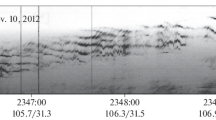Abstract
The event of March 11, 2011 was used to study decimeter-wave microflares (MF) in solar active regions. A theoretical interpretation has been proposed for the nature and generation mechanism of decimeter-waveMFs, which is based on an analysis of the phenomenon of double plasma resonance and subsequent transformation of upper hybrid waves when they interact with low-frequency plasma waves. It is shown that MFs should form in the active regions between magnetic fields of opposite direction, where magnetic-field strength reaches 100–150 G in the transition region. We report the spectral properties of MFs computed with the allowance for inverse bremsstrahlung and cyclotron absorption and for the increment of upper-hybrid waves. It is shown that the transition region is the most likely place of MF generation within the framework of the model of electron-density and temperature. It is also shown that within the framework of electron density and temperature model in the active region the most likely MF generation place in the solar atmosphere is the transition region. MFs were observed at frequencies from 1.036 to 1.306 Hz, which is consistent with model computations.
Similar content being viewed by others
References
V. M. Bogod, Q. Fu, and L. V. Yasnov, ESA SP 448, 1041 (1999).
V. M. Bogod, C. Mercier, and L. V. Yasnov, J. Geophys. Res. 106, 25353 (2001).
V. M. Bogod and L. V. Yasnov, Astronomy Reports 45, 643 (2001).
V. M. Bogod and L. V. Yasnov, Astron. Astrophys. Transactions 20, 459 (2001).
V. M. Bogod and L. V. Yasnov, Astronomy Reports 49, 144 (2005).
L. V. Yasnov, V. M. Bogod, and A. G. Stupishin, Solar Physics 249, 37 (2008).
V. V. Zhelezniakov and E. Y. Zlotnik, Solar Physics 43, 431 (1975).
V. V. Zhelezniakov and E. Y. Zlotnik, Solar Physics 44, 461 (1975).
C. L. Selhorst, N, A. Silva-Valio, and J. E. R. Costa, Astron. and Astrophys. 488, 1079 (2008).
J. Kuijpers, Astron. and Astrophys. 40, 405 (1975).
L. V. Yasnov, Solar Physics 289, 1215 (2014).
D. G. Wentzel, Astron. and Astrophys. 100, 20 (1981).
D. G. Wentzel, Solar Physics 103, 141 (1986).
S. D. Spicer, A. O. Benz, and J. D. Huba, Astron. and Astrophys. 105, 221 (1981).
V. V. Zheleznyakov, Radiation in Astrophysical Plasma (Yanus-K, Moscow, 1997)
R. M. Winglee and G. A. Dulk, Astrophys. J. 307, 808 (1986).
L. V. Yasnov and M. Karlicky, Solar Physics 219, 289 (2004).
A. A. Kuznetsov and Y. T. Tsap, Solar Physics 241, 127 (2007).
Author information
Authors and Affiliations
Corresponding author
Additional information
Original Russian Text © L.V. Yasnov, V.M. Bogod, A.A Gofman, O.M. Stupishina, 2017, published in Astrofizicheskii Byulleten’, 2017, Vol. 72, No. 1, pp. 63–72.
Rights and permissions
About this article
Cite this article
Yasnov, L.V., Bogod, V.M., Gofman, A.A. et al. Spectrum and physical conditions in microflare generation regions at decimeter-wave frequencies. Astrophys. Bull. 72, 58–66 (2017). https://doi.org/10.1134/S1990341317030075
Received:
Revised:
Published:
Issue Date:
DOI: https://doi.org/10.1134/S1990341317030075



